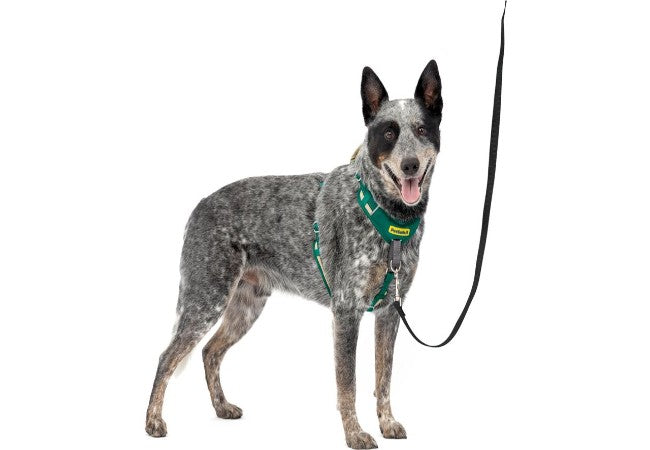Vet Approved Guide No-Pull Dog Harnesses Why You Need One 2025 🦮

In this article
Vet Approved Guide No-Pull Dog Harnesses Why You Need One 2025 🦮
By Dr. Duncan Houston BVSc
Walking a dog that pulls is frustrating—and for some owners, downright dangerous. As a veterinarian, I often help pet parents improve leash manners using safe, science-backed equipment. One of the best tools? A no-pull harness. These harnesses are designed to redirect your dog’s energy and reduce pressure on their neck. In this guide, we’ll explore how no-pull harnesses work, their benefits, how to fit them correctly, and introduce the 🧭—my top pick for safety, durability, and comfort. 🐕🚶♀️
🔍 What Is a No-Pull Dog Harness?
A no-pull harness is a specially designed walking aid that discourages dogs from pulling on the leash. It differs from traditional back-clip harnesses or collars by providing better control without choking or hurting the dog.
Most no-pull harnesses feature a front clip attachment (at the chest) and/or a dual clip system (chest and back) to allow more customized control. When the dog pulls, the front clip redirects their momentum to the side—naturally curbing forward movement and reducing their ability to drag you down the street. 🐾
🧠 How Do No-Pull Harnesses Work?
No-pull harnesses work through three main mechanisms:
- Redirection: A leash clipped to the chest turns the dog toward you when they pull, discouraging the behavior.
- Even Pressure Distribution: Pressure spreads across the shoulders and chest, not the neck, reducing risk of injury.
- Leverage: Front clips offer more control, especially for strong or excitable dogs.
This creates a walking dynamic where the dog learns pulling doesn’t get them where they want to go. Instead, staying by your side becomes more rewarding—and more comfortable. 🎯🐕
💥 Why Collars Aren’t Ideal for Pullers
Standard collars, even flat ones, put direct pressure on the trachea and cervical spine. For strong pullers or brachycephalic breeds (like Pugs or Bulldogs), collars can cause:
- Choking or coughing
- Tracheal collapse (especially in small breeds)
- Neck muscle strain or spinal compression
- Behavioral escalation due to discomfort
That’s why vets and certified trainers recommend no-pull harnesses as a safer, more humane option for leash training. 🩺✅
🚶 Benefits of Using a No-Pull Harness
Switching to a no-pull harness can transform your walks—both physically and behaviorally. Key benefits include:
- ✅ Improved control over large or excitable dogs
- ✅ Reduced risk of injury to you and your pet
- ✅ Enhanced training feedback during leash sessions
- ✅ Increased comfort, especially for senior or sensitive dogs
- ✅ Less stress, more enjoyment on daily outings
When paired with reward-based training, many dogs stop pulling altogether within weeks. 🏆
🧭 Featured Pick
If you're looking for a durable, vet-approved option. Here's why it stands out:
- 🐕 Dual-clip design for both training and everyday use
- 🧵 Padded chest panel and breathable mesh for comfort
- 🎯 Reflective stitching for visibility and safety
- 🛡️ Adjustable straps for a secure, customized fit
- 🌍 Eco-conscious materials and construction
It's available in multiple sizes and colors to suit dogs of all shapes and personalities. Whether you're tackling reactivity, puppy training, or just seeking a safer alternative to a collar, the Explorer is your go-to gear. 🐶
📏 How to Fit a No-Pull Harness Properly
Proper fit is essential for function and comfort. Follow these tips:
- Measure your dog’s girth (the widest part of the chest) and neck
- Choose a harness with adjustable straps
- Ensure you can fit two fingers between the harness and your dog
- Watch for rubbing or gaps that could cause discomfort
Always allow your dog to get used to the harness at home before heading out for a walk. Use treats and praise to build positive associations. 🦴
📚 Training Tips to Pair with Your Harness
1. Use “Stop and Go” Training
When your dog pulls, stop walking. When the leash slackens, praise and walk forward. Consistency teaches that pulling gets them nowhere. 🚫➡️
2. Practice “Heel” with Rewards
Reward your dog for walking beside you with treats or praise. Use a marker word like “yes!” when they’re in the correct position. 🐕🍖
3. Use Distraction Techniques
Redirect focus using cues like “watch me” or scattering treats (“find it”) when you see a trigger or feel tension build. 🎯
4. Gradually Increase Distractions
Start in quiet areas before progressing to busier environments. This builds confidence and reinforces calm behavior in real-world settings. 🌳➡️🛣️
🧠 Ideal Dogs for No-Pull Harnesses
No-pull harnesses are ideal for:
- 🐾 Puppies learning leash manners
- 🧠 Reactive or anxious dogs needing control without stress
- 💪 Strong breeds (Boxers, Shepherds, Huskies)
- 👵 Senior dogs who need gentle pressure distribution
- 🎓 Newly adopted dogs or rescues
In short, they benefit nearly all dogs—and make walks better for both ends of the leash. 🐾❤️
🩺 When to Talk to a Vet or Trainer
If your dog continues to pull excessively or displays reactivity, consult your vet to rule out pain, vision issues, or anxiety. Behavior experts can create customized plans that pair training and equipment like the Woopf Explorer Harness for lasting results.
Need fast support? Use the Ask A Vet app to consult a licensed veterinarian about gear, training, or behavior concerns—anytime. 📱🩺
✅ Final Thoughts
No-pull dog harnesses offer a safe, effective, and humane way to enjoy peaceful, injury-free walks. Combined with positive reinforcement and the right fit, they’re a game-changer for training and everyday control.
Quick Recap:
- 🦮 No-pull harnesses reduce pulling through redirection and control
- 👎 Collars can cause injury for dogs that pull hard
- 📏 Proper fit and training enhance results
- 📲 Use Ask A Vet for expert support anytime
Need help choosing or fitting your harness? Visit AskAVet.com or download the app to speak with a licensed vet today.🧭🐾






